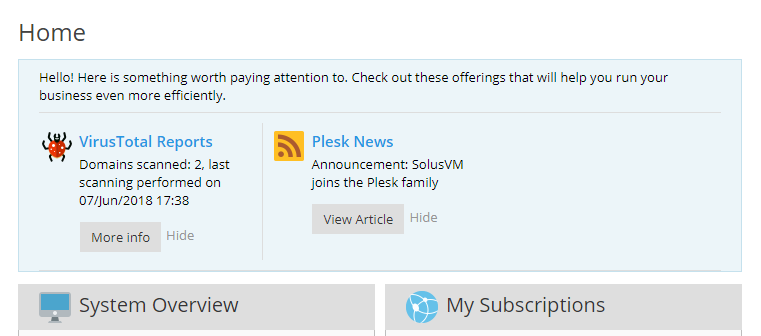Integrate to Home Page
Extensions can communicate various information by placing info blocks (also referred to as widgets) to the administrator’s and customers’ Home pages in Plesk.

To do that, include in your extension a class that extends
pm_Promo_AdminHome
or
pm_Promo_CustomerHome
and overrides the necessary methods. All classes that extend
pm_Promo_AdminHome and pm_Promo_CustomerHome are loaded when a
user navigates to the Home page.
Note: Make sure to follow the Class Naming Conventions for the classes you implement. Otherwise, the classes may not be properly loaded.
For example, in an extension with an ID "my-module", a new class
implementing an info block for the administrator’s Home page should
be named Modules_MyModule_Promo_AdminHome. Its code should be placed
in the file plib/library/Promo/AdminHome.php.
“Plesk News” info block on the screenshot above is displayed by the sample extension “Panel News”. Its source code is available here: https://github.com/plesk/ext-panel-news
Example: defining an info block
This example demonstrates an implementation of a info block. It uses the following methods:
Use the following code:
<?php
class Modules_MyModule_Promo_AdminHome extends pm_Promo_AdminHome
{
public function getTitle()
{
return 'Add Block Title Here';
}
public function getText()
{
return 'Add your text here...';
}
public function getButtonText()
{
return 'View';
}
public function getButtonUrl()
{
return 'http://example.com';
}
public function getIconUrl()
{
pm_Context::init('my-module');
return pm_Context::getBaseUrl() . '/images/icon.png';
}
}
Note: When you need to use the functions provided by the Extensions API,
you need to define context in the method body by calling
pm_Context::init('module ID').
The getButtonText() and getIconUrl() methods are optional. If
you omit these methods, Plesk will use the default button caption
(“Learn more”) and icon.